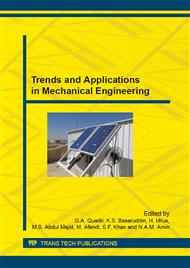[1]
R. N. van Gent, D. Siem, M. van Middelkoop, a G. van Os, S. M. a Bierma-Zeinstra, and B. W. Koes, Incidence and determinants of lower extremity running injuries in long distance runners: a systematic review, Br. J. Sports Med. 41 (2007) 469–480.
DOI: 10.1136/bjsm.2006.033548
Google Scholar
[2]
R. Chang, P. a Rodrigues, R. E. a Van Emmerik, and J. Hamill, Multi-segment foot kinematics and ground reaction forces during gait of individuals with plantar fasciitis, J. Biomech. 47 (2014) 2571–2577.
DOI: 10.1016/j.jbiomech.2014.06.003
Google Scholar
[3]
A. Chard, A. Greene, A. Hunt, B. Vanwanseele, and R. Smith, Effect of thong style flip-flops on children ' s barefoot walking and jogging kinematics, J. Foot Ankle Res. 6 (2013) 1-9.
DOI: 10.1186/1757-1146-6-8
Google Scholar
[4]
C. Wegener, D. O. Meara, A. E. Hunt, J. Burns, B. Vanwanseele, A. Greene, and R. M. Smith, Three-dimensional ankle kinematics in children's school shoes during running, J. Foot Ankle Res. 5 (2012) S1-O20.
DOI: 10.1186/1757-1146-5-s1-o20
Google Scholar
[5]
R. Smith, S. Y. Tong, D. O. Meara, and B. Vanwanseele, Effect of footwear on lower limb kinematics in children during sidestep, Proc. Int. Conf. Biomech. Sport 31 (2013).
Google Scholar
[6]
J. D. Willson, J. S. Bjorhus, D. S. B. W. Iii, R. J. Butler, J. P. Porcari, and T. W. Kernozek, Short-Term Changes in Running Mechanics and Foot Strike Pattern After Introduction to Minimalistic Footwear. 6 (2014) 34–43.
DOI: 10.1016/j.pmrj.2013.08.602
Google Scholar
[7]
K. Hollander, D. Riebe, S. Campe, K. -M. Braumann, and A. Zech, Effects of footwear on treadmill running biomechanics in preadolescent children, Gait Posture. 40 (2014) 381–385.
DOI: 10.1016/j.gaitpost.2014.05.006
Google Scholar
[8]
T. Hein and S. Grau, Can minimal running shoes imitate barefoot heel-toe running patterns ? A comparison of lower leg kinematics, Sport Health Sci. (2014). (in press).
DOI: 10.1016/j.jshs.2014.03.002
Google Scholar
[9]
A. Barnes, J. Wheat, and C. E. Milner, Use of gait sandals for measuring rearfoot and shank motion during running, Gait Posture. 32 (2010) 133–135.
DOI: 10.1016/j.gaitpost.2010.01.015
Google Scholar
[10]
C. Morio, M. J. Lake, N. Gueguen, G. Rao, and L. Baly, The influence of footwear on foot motion during walking and running, J. Biomech. 42 (2009) 2081–(2088).
DOI: 10.1016/j.jbiomech.2009.06.015
Google Scholar
[11]
E. A. Cunningham and S.D. Perry, Rearfoot kinematic differences between level treadmill and level ground running, J. Biomech. 40 (2007) S515.
DOI: 10.1016/s0021-9290(07)70505-5
Google Scholar
[12]
B. De Wit, D. De Clercq, and P. Aerts, Biomechanical analysis of the stance phase during barefoot and shod running, J. Biomech. 33 (2000) 269–278.
DOI: 10.1016/s0021-9290(99)00192-x
Google Scholar


